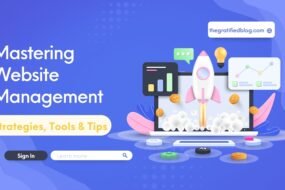
Creating a loading page for your website is essential to improving user experience.
Including a loading screen can decrease abandoned visits, improve user experience, and give you time to load additional content or resources.
Remember these best practices when creating your loading page to ensure traffic stays on your site!
What Is Loading Page?
A loading page, also known as a loading screen or splash screen, is a web page displayed while the rest of the pages on the website are loading.
This is an essential part of your website because it can help to improve user experience and decrease abandoned visits. In this blog post, we will explore the elements contributing to the necessity for a loading page, the benefits of loading pages, and some best practices for creating loading pages that will help keep traffic on your site!
On the off chance that your pages are content-weighty, you will benefit from a site-loading page. This is connected with your WordPress SEO and could cause critical issues. Furthermore, there are a few conditions wherein a site could always be unable to stack rapidly for most traffic.
This issue will probably happen on endlessly looking over pages; any site has a few basic pages in excess. Also, each content, module, and data set question will add to your stacking times expansion. When this becomes an issue, a few sites pick a loading page instead of burning through energy to lessen the size of the page or picking one-page site layouts.
A loading page is a static picture or vivified CSS loader shown on-screen while the site stacks behind the scenes. The loading pages are stand-out stacking screens that draw in your watchers while your server processes your substance.
One way to enhance the loading page experience is by incorporating an engaging page loading animation. This animation can captivate your visitors’ attention and provide visual interest while they wait for your website to load.
The loading page’s activity, including the captivating animation, completes when the site is wholly stacked and fit to be shown, and your page is displayed to guests. Incorporating a well-designed animation can alleviate the monotony of watching a page load component by component.
Moreover, it eliminates the disruption caused by guests staring at a transparent screen, unsure whether your page is even loaded. Like some stacking screens, various loading pages are organized and marked with a logo or brief liveliness.
Although many website composition firms disregard them, some UX configuration research investigations have discovered that loading pages is a fundamental part of a site’s insight. An appropriately situated loading page consoles your guests that the site has not crashed
Their program is bustling with handling information. A particular stacking screen often settles on your guest staying on your site or clicking away decisively. You can maximize your guests’ advantage satisfactorily using a stacking screen movement.
Although stacking screen movements can be complex, the most real liveliness planned utilizing HTML5 activity devices can help your clients. The loading page looks decent and gives a solid initial feeling, especially vivified ones.
An excellent loading page should likewise disappoint and exhibit something significant to your business, such as showcasing effective business growth strategies. Controlling visitors’ assumptions by seeing what’s in the store would keep them intrigued for longer.
By strategically incorporating captivating visuals and enticing content, you can engage potential customers and pique their interest in your business’s growth strategies. This approach not only enhances user experience but also contributes to the overall success of your business by attracting and retaining valuable prospects.
Why Is A Loading Page Important For Your Website?
A loading page is essential for your website because it can help to improve user experience and increase foot traffic. Upon visiting your website, users will be greeted by a loading page that lets them know the rest of the site is loading.
This can help decrease abandoned visits because users will know that the site is loading and will not have to wait for all the content to load before they can use the site. By efficiently managing the loading process, you can ensure that your website attracts and retains more foot traffic, providing a smoother browsing experience for your users.
Have you at any point shown up at a page where the stacking image proceeds to blaze, and you’re uncertain on the off chance that the substance will show or, on the other hand, on the off chance that you ought to close the tab? By and large, I am inclined toward the last option.
Google found that more clients would forsake a site that takes more than three seconds to stack. That depends on private experience. However, numerous others would concur.
Loading pages is vital nowadays, as capacities to focus proceed to psychologists and Internet associations work on strength and speed. Specific sites are much more regrettable since they are short on stacking pointers instead of showing a plain white page.
These outcomes are in a more critical bob rate. Assuming I needed to explain that for you, the following are a couple of justifications for why loading pages is beneficial:
- Let clients know your site has not crashed or hung; it is just stacking.
- Give your purchasers something to do while they trust the material will stick.
- To reinforce your memorability and establish a connection (some loading pages permit you to tweak it with the goal that your image is upfront even before clients see your substance)
The importance of loading pages are:
Improves User Experience
Loading page optimization is a crucial aspect of enhancing UX by loading content in the background while a user can see something happening on screen. These loading pages, including landing page optimization, bridge the user’s intent and the desired information, ensuring a seamless business browsing experience.
With loading pages, websites can cleverly optimize the loading process, preloading essential data and resources, thereby reducing the waiting time for users. By implementing efficient loading page techniques, such as lazy or asynchronous loading, businesses can prioritize displaying crucial content and gradually load additional elements as the user explores the page.
This approach not only improves the perceived speed of the business website but also keeps users engaged and prevents them from bouncing off due to long loading times and. and incorporating loading page examples, including business website design, that dynamically load and display content can significantly contribute to a smooth and satisfying user experience.
Reduce Abandoned Visits
A loading page is crucial for a website as it informs users that the site is loading and they don’t have to wait for all content to load before using it, thus enhancing search visibility. This helps reduce abandoned visits as users know that the site is still loading and can start using it.
According to a survey by Digital.com, half A significant percentage of visitors leave a website if it exceeds a specific duration of 6 seconds to load. In comparison, Over 53% of mobile users will leave websites that require more than 3 seconds to load. Slow-loading pages are the primary source of dissatisfaction for 21% of consumers when shopping online, and businesses with slow-loading pages leave a negative impression on 45% of customers.
Hence, guaranteeing swift website loading is crucial to avoid losing potential customers and improve its search visibility. Adding a loading animation or gif to the site can keep users entertained while waiting for the rest of the site to load, further enhancing the overall user experience and search visibility.
Disadvantage Of Loading Page
While loading pages has become faster and more efficient with technological advancements, there are still a few disadvantages. Here are some common disadvantages of loading pages: Slow Loading Times:
A delayed loading time for a web page can result in an unsatisfactory user experience, a crucial aspect for website owners to consider. Incorporating Google Analytics into your website enables you to monitor and analyze performance metrics, including page load times.
Visitors might grow impatient and leave the page if it loads slowly, resulting in a higher bounce rate. Moreover, slow loading times can adversely affect Search engine rankings, as Google and other search engines prioritize websites that load quickly.
Therefore, leveraging Google Analytics enables you to gather valuable insights on page load speeds and take necessary measures to optimize your website’s performance.
- Increased Bounce Rate:
If a website takes less time to load, users are likelier to leave before the content is displayed. This can result in a higher bounce rate, indicating that visitors must engage more with the website. To address this issue, web admins can utilize tools like Google Search Console, which provides valuable insights into site performance and user behavior.
By analyzing data from the Search Console, Owners of websites can pinpoint areas for enhancement and optimize their website’s loading speed. This proactive strategy not only improves user experience but also has the potential to impact conversion rates positively.
- Negative User Experience:
A user encountering a slow-loading page can result in frustration and foster a negative perception of the website or brand. Users may perceive the website as unreliable, unprofessional, or outdated, impacting their trust and willingness to return.
One effective solution to enhance the user experience and mitigate such issues is leveraging the Gravity Forms plugin. By integrating Gravity Forms, website owners can optimize the performance of their forms, ensuring they load quickly and smoothly.
This not only improves user satisfaction but also enhances the overall perception of the website, making it appear more dependable, professional, and up-to-date…
- Limited Accessibility:
Slow-loading pages can be problematic for users with slow internet connections or restricted data plans, making it difficult for them to access and navigate the website effectively. This can lead to a less inclusive online experience, as these users may be excluded from using the website.
Ensuring web accessibility is crucial for developers and organizations aiming to develop top-notch websites and web tools without excluding individuals from accessing their products and services. The impact of the COVID-19 crisis varies widely at regional and local levels, posing substantial implications for crisis management and policy responses.
Future technological innovation will keep transforming healthcare, yet while technologies will drive innovation, human factors will remain one of the stable limitations of breakthroughs.
- Impact On Mobile Users:
Internet speeds on mobile devices are frequently slower when compared to desktop computers. Suppose a website is not optimized for mobile devices and has slow loading times. In that case, it can significantly impact the mobile user experience and deter mobile users from accessing or engaging with the website.
However, solutions are available to improve websites’ performance on mobile devices. One such solution is the Hummingbird plugin, which is designed to optimize website loading times and enhance mobile device user experience.
By incorporating the Hummingbird plugin into the website’s design, developers can ensure that it Loads rapidly and smoothly, delivering a seamless browsing experience for mobile users. With the help of the Hummingbird plugin, website owners can overcome the challenges posed by slower internet speeds on mobile devices and create a mobile-friendly environment that attracts and retains users.
- SEO Implications:
Website loading speed is essential for search engine optimization (SEO). Slow-loading pages can negatively impact a website’s search engine rankings, making it more challenging for users to discover the website through search engines.
Page speed is an umbrella term that refers to how fast the content on a page loads, and it is affected by various factors such as web hosting and page size. Faster loading times can contribute to higher rankings, while slow loading times can decrease SEO rankings.
According to Google, 53% of users abandon a website if it exceeds a 3-second loading time, highlighting the importance of page load speed in user engagement and website rankings.
To mitigate these disadvantages, web developers and designers should prioritize optimizing loading times by reducing file sizes, leveraging caching techniques, using efficient coding practices, and optimizing server responses.
Additionally, mobile responsiveness and integration of accessibility considerations are essential in designing and developing the website.
Best Loading Page UX Examples That Will Help Traffic To Wait
There are a few things to remember when creating a loading page for your website. Here are some loading page UX examples that will help keep traffic on your site:
- Use Relevant And Engaging Images Or Videos
One of the best ways to keep traffic engaged. At the same time, they wait for your website to load by incorporating relevant and visually appealing images or videos into your loading page. These captivating visuals enhance the overall aesthetics and offer a great chance to express your brand message effectively.
You can choose images that are directly related to your brand, products, or the overall theme of your website, creating a seamless connection between your content and visual elements. To ensure you find the perfect images that align with your website’s purpose, you can leverage tools such as Google Advanced Image Search, which offers a wide range of search parameters and filters to refine your image selection process.
Utilizing such tools lets you quickly discover and Utilize high-quality images that resonate with your audience and elevate their loading experience. By providing an aesthetically pleasing and engaging visual experience with the help of it, you can effectively captivate users and increase their patience during the loading process.
Use relevant and engaging images or videos.
For Example, if you have a website related to home decor. Then, you should use this image.
- Include A Progress Bar So Users Know How Much Longer They Have To Wait
A progress bar is an essential element to include on your loading page. It gives users a clear indication of how much longer they have to wait before the website is fully loaded.
Seeing a progress bar helps manage user expectations and reduces frustration, as they can track the loading process and estimate the remaining time.
This simple feature can significantly enhance the user experience and make the waiting time more manageable.
- Use Concise Text To Explain What Is Happening.
Regarding the text on your loading page, it’s crucial to keep it concise and informative. Use clear and straightforward language to explain what is happening during the loading process.
For example, you can provide a brief message such as “Loading website…” or “Preparing your experience.” Avoid technical jargon or lengthy explanations that may confuse or overwhelm users.
By keeping the text concise, you give users a sense of transparency and reassure them that progress is being made.
- Include A Call To Action So Users Know What To Do Next Once The Site Has Loaded.
Including a call to action (CTA) on your loading page effectively guides users on what to do next once the site has loaded.
This can be as simple as a button that says “Explore” or “Get Started.” By providing a clear next step, such as a compelling CTA, you encourage users to continue engaging with your website and prevent them from disengaging or leaving.
The different types of CTA’s you can consider include “Sign Up,” “Shop Now,” “Learn More,” or “Request a Demo.” The call to action should be prominently displayed and easily clickable, ensuring a seamless transition from the loading page to the main content.
Conclusion
Concerning this subject, I concur loading pages is an excellent job! Loading pages merit putting resources into it by some stroke of good luck to improve the probability of guests staying on your site for a lengthy period.
With crowds’ ability to focus so short, you should do all conceivable to inspire even the littlest positive response. The ROI is more alluring than the risk of neglecting to work on your site.








No Comments